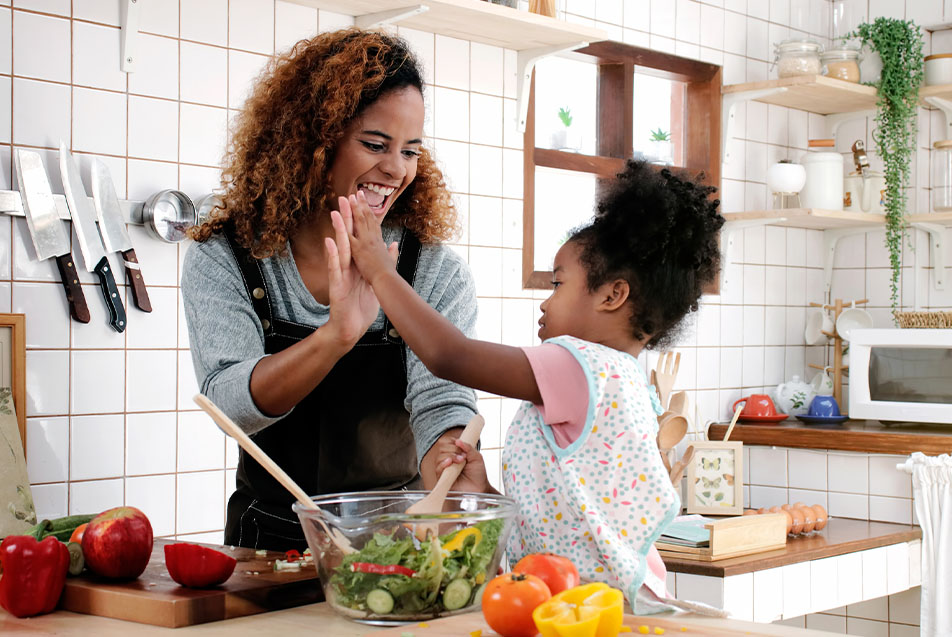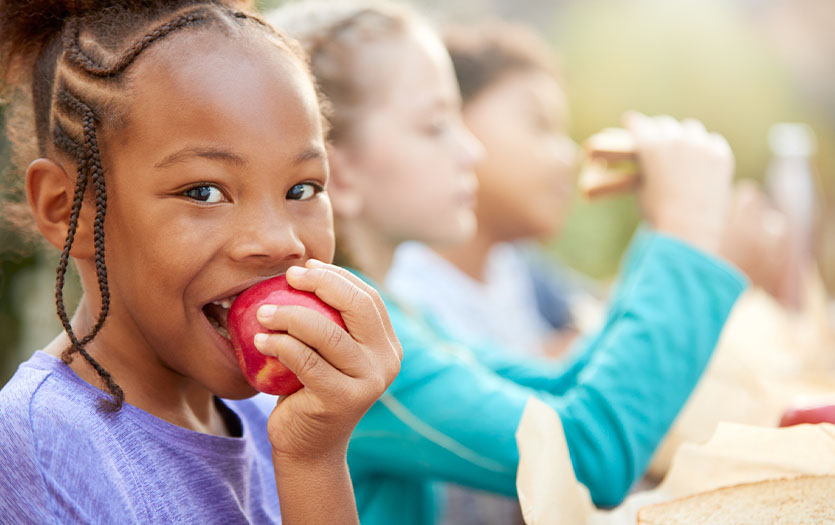
This post was written by Katie Fulk, MA, RDN, LD, Youth and Family Well-Being, community outreach dietitian, Parkview Health.
From the age of six months to eighteen, the average child consumes roughly nineteen thousand meals. That’s nineteen thousand opportunities for parents, grandparents and caregivers to raise healthy, independent eaters! We know that with great opportunity comes great responsibility, and the food and nutrition world is not an easy space to navigate. The good news is, there’s no rulebook to follow or punishment for a “less than perfect” feeding regimen. It’s the sum of our efforts that leaves a lasting impression on the children around us.
Family feeding tips for success
There is no time like the present to commit to creating healthy food habits for yourself and your children. To get started, try these five family feeding tips for success.
Tip No. 1 – Adults provide, children decide.
That means that the adult provides a balanced meal and then leaves it up to the child to decide how much and what they eat of the served meal. Sounds wild, right? In fact, this method grants children the opportunity to connect with their hunger and fullness cues. If you notice that your child is avoiding the steamed vegetables, don’t fret and remember, there are thousands more opportunities to serve this food again to eventually become a more familiar food. If the child isn’t ready to try a new food, no big deal. It can take numerous exposures to a food before a child is ready to take food from plate to mouth. You can find more information on creating a balanced meal and nutritional information at myplate.com.
Tip No. 2 – Use positive food language.
Phrases like “clean plate club” and “just two more bites” are tactics of the past! These phrases can cause more harm than good as they can unknowingly encourage eating beyond comfortable fullness. Not to mention the obvious emphasis that we are putting on the “healthiest” food on the plate too often earn an “unhealthy” food reward, such as dessert or screen time. Aim to avoid classification of healthy and unhealthy foods altogether. Consider discussing how all foods can support a healthy, growing body.
“Can you find the orange food? Orange foods help keep our eyes healthy.”
Aim to find a balance in offering both “growing foods” and “fun foods.” Growing foods tend to be those that are bursting with nutrients, such as fruits, vegetables, whole grains and lean proteins. Growing foods should be offered most of the time. Offer a small amount of fun foods such as cookies, cake and ice cream some of the time to enjoy just to reach comfortable fullness.
Tip No. 3 – Ask for a sous chef.
Allowing children to help in the food planning and preparation process can greatly inspire curiosity and creativity, all while building healthy lifestyle skills. Asking, “Should we have broccoli or green beans for dinner?” instead of, “What veggie should we have?” allows you to provide the balance and the child can decide which they prefer to increase acceptance at mealtime. Once in the kitchen, ask children to be your sous chef, whether that be gathering and washing produce foods, mixing ingredients, or setting the table. These tasks not only assist you as the head chef, but also create and foster healthy habits within the food environment.
Tip No. 4 – Serve “family style.”
Picture your shared eating space. Now place all items of your favorite meal in the center of the table to be passed around, item by item. This family style of eating allows everyone to serve themselves, which can help develop good table manners, independent food choices, and relieves the pressure of trying a new-to-you food. Children learn by watching others and your example can greatly influence their actions.
Tip No. 5 – Make “together meals” a priority.
The fondest memories are made when gathered around the table! It’s a fact that those who enjoy most meals and snacks together as a household tend to consume more fruits and vegetables, establish family connectivity and bonding, enjoy communication, and experience an environment that supports one’s emotional well-being. As you enjoy your “together meal,” keep things positive, avoiding negative food talk or food arguments. Regardless of what happens after providing your family with a balanced meal, let your biggest success be that you are at the table together.
Interested in learning more?
My list for developing positive dietary habits could go on and on. As mentioned above, opinions in the nutrition world are vast and often confusing. Thankfully, Parkview offers an abundance of free classes and resources to help guide individuals and families on their health and well-being journeys. You can see a complete list of Classes and Events on parkview.com.
Confidently Feed Your Family via Zoom
February 8, 5:30-6:15 p.m.
All parents and caregivers are encouraged to join us for an engaging family feeding virtual discussion over Zoom!?In this judgment-free zone, we will have an open forum to talk about fresh ideas on healthy eating for your family. During each session, we mix in a fresh new topic, provide a bowlful of guidance, a spoonful of resources, and a ladleful of answers to your pressing questions. This recipe yields healthy kids and harmony around the table! Call 260-266-6500 or toll free at 844-835-0003 to register. (A Zoom link will be sent prior to the event.)
Nutrition and Cooking Class: Kids in the Kitchen
February 21 5:30-7 p.m.
Parkview Center for Healthy Living – Woodland Plaza Center for Healthy Living, Community Greenhouse & Learning Kitchen
It is a fact, kids who know how to cook enjoy eating wholesome foods. Kids in the Kitchen is a hands-on cooking and nutrition class for children. In the class, they will receive practical nutrition education on the MyPlate diagram, kitchen safety and how to read a recipe. Then, students will have an opportunity to follow a recipe and create their own dish. Registration closes on February 20 at noon. Call 260-266-6500 or toll free at 844-835-0003 to register. (Note: One adult must attend with each child. Registration is limited to 8 child/adult pairs.)
To stay informed about upcoming health and well-being offerings, be sure to sign up for our monthly newsletter.



